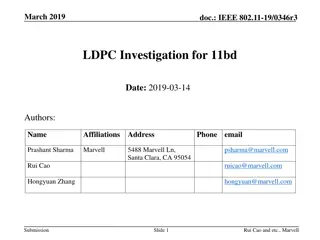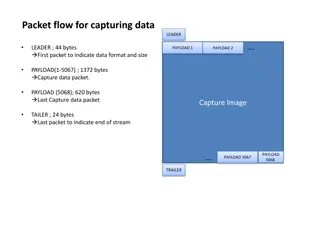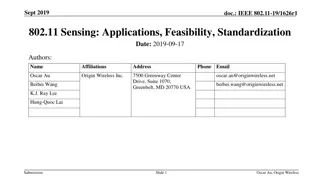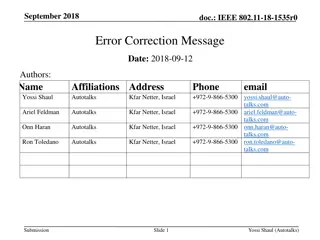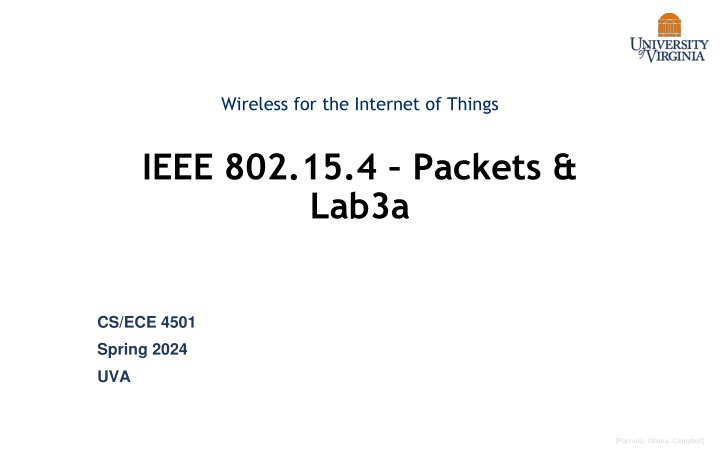
IEEE 802.15.4 Wireless for Internet of Things Packets & Lab Insights
Explore the IEEE 802.15.4 wireless protocol for Internet of Things devices, including packet formats, frame controls, and frame types. Learn about synchronization preambles, MAC frame structures, and the significance of frame types like beacons and data frames in IoT communications.
Download Presentation

Please find below an Image/Link to download the presentation.
The content on the website is provided AS IS for your information and personal use only. It may not be sold, licensed, or shared on other websites without obtaining consent from the author. If you encounter any issues during the download, it is possible that the publisher has removed the file from their server.
You are allowed to download the files provided on this website for personal or commercial use, subject to the condition that they are used lawfully. All files are the property of their respective owners.
The content on the website is provided AS IS for your information and personal use only. It may not be sold, licensed, or shared on other websites without obtaining consent from the author.
E N D
Presentation Transcript
Wireless for the Internet of Things IEEE 802.15.4 Packets & Lab3a CS/ECE 4501 Spring 2024 UVA [Pannuto, Ghena, Campbell]
Base packet format IEEE 802.15.4 Synchronization Preamble: four bytes of zeros Q: How many chips? Start-of-Packet: 0xA7 PHY Header One field: length 0-127 Why still 8 bits? Because computers depend on bytes 2
MAC frame format Octets:2 1 0/2 0/2/8 0/2 0/2/8 variable 2 Destination PAN identifier Source PAN identifier Destination address Source address Frame check sequence Frame control Header Frame control Sequence number Frame payload Addressing fields MAC payload MAC header MAC footer Frame payload Depends on frame type Sequence number 8-bit monotonically increasing Addressing fields PAN and addresses Varies based on frame type Frame check sequence 16-bit CRC 3
Frame control Octets:2 1 0/2 0/2/8 0/2 0/2/8 variable 2 Destination PAN identifier Source PAN identifier Destination address Source address Frame check sequence Frame control Sequence number Frame payload Addressing fields MAC payload MAC header MAC footer Bits: 0-2 3 4 5 6 7-9 10-11 Dest. addressing mode 12-13 14-15 Source addressing mode Security enabled Frame pending Frame version PAN ID compression Frame type Ack. Req. Reserved Why no length field? Frame type Type of payload included Security enabled Packet is encrypted (extra 0-14 byte header) Frame pending Fragmented packet Acknowledgement required PAN ID compression No PAN ID if intra-network Already in prior header Addressing modes Which fields to expect 4
Frame types - Beacon Beacon Information about the communication structure of this network Sent in response to requests from scanning devices Sent periodically at start of Superframes (if in use) Sent without CSMA/CA MAC Header Source address only, broadcast to everyone Packet contents Superframe details, including Guaranteed Time Slots (if any) Pending addresses lists devices for which Coordinator has data 5
Frame types - Data Data Data from higher-layer protocols MAC Header Source and/or Destination addresses as necessary Packet Contents Whatever bytes are desired (122 bytes address sizes) May be fragmented across packets 6
Frame types MAC Command MAC Command Various commands for supporting link layer Join/leave network Change coordinator within network Request data from coordinator Request Guaranteed Time Slot MAC Header Source and/or Destination addresses as necessary 7
Frame types - Acknowledgement Acknowledgement Acknowledges a Data or MAC Command packet Not beacons or other acknowledgements What happens if acknowledgement isn t received? Packet will be transmitted again MAC Header Repeats Sequence Number of acknowledged packet No Source or Destination addresses Sent TIFSafter the packet it is acknowledging (immediately) 8





